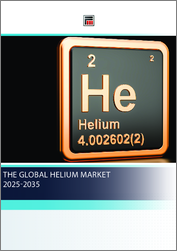
|
시장보고서
상품코드
1623584
세계의 헬륨 시장(2025-2035)The Global Helium Market 2025-2035 |
||||||
세계 헬륨 시장은 공급 역학의 변화와 수요 패턴의 변화로 인해 크게 변화하고 있습니다. 현재 시장 환경은 전통적인 응용 분야와 새로운 응용 분야 간의 복잡한 상호 작용을 반영하고 있으며, 반도체 산업이 세계 수요의 약 24%를 차지하는 압도적인 소비자로 부상하고 있습니다. 이는 극저온 애플리케이션, 특히 의료용 영상 애플리케이션이 소비의 대부분을 차지했던 과거 패턴과는 확연히 달라진 모습입니다. 미국, 카타르, 알제리 등 주요 생산 지역이 다양한 도전에 직면하면서 공급 제약이 시장 역학에 영향을 미치고 있습니다. 미국 Federal Helium Reserve의 역할이 줄어들면서 상업 중심의 시장 구조로의 전환이 가속화되고 있으며, 카타르의 LNG 프로젝트 확장은 세계 공급 패턴에 큰 변화를 가져오고 있습니다. 러시아 프로젝트, 특히 아무르 시설은 세계 공급에 기여하는 데 영향을 미치는 개발 과제에 직면해 있습니다.
현재 전 세계 생산능력은 연간 약 1억 7,500만 입방미터로 수요와 공급이 거의 일치하고 있습니다. 이러한 긴박한 시장 균형은 가격 상승 압력을 유지하고 있으며, 일부 지역에서는 공급 중단 시 큰 변동이 발생하고 있습니다. 시장은 이 중요한 가스의 세계 유통 및 저장 문제를 반영하여 가격 및 공급 능력에 지역적 차이를 보이고 있습니다. 향후 수요는 2035년까지 연평균 5-6% 성장할 것으로 예상되며, 이는 주로 반도체 제조, 양자 컴퓨팅 애플리케이션 및 신기술에 기인합니다. 특히 아시아 지역의 반도체 산업이 확대되면서 2030년까지 아시아 지역이 전 세계 소비에서 차지하는 비중이 30%를 넘어설 것으로 예상됩니다. 이러한 성장은 공급망에 더 많은 압력을 가하고 새로운 생산원의 필요성을 강조합니다.
캐나다, 탄자니아, 남아프리카에서 개발 중인 새로운 헬륨 프로젝트는 잠재적인 공급 다변화 가능성을 제공하지만, 개발 일정이 아직 길어지고 있습니다. 이러한 프로젝트는 일반적으로 질소 함량이 높은 가스 스트림의 고농도 헬륨을 대상으로 하며, 기존의 천연가스 기반 채굴에 비해 더 경제적인 생산을 가져올 수 있습니다. 저장 및 재활용 기술은 점점 더 중요해지고 있으며, 주요 사용자들은 95% 이상의 효율을 달성하는 정교한 회수 시스템을 도입하고 있습니다. 이러한 추세는 특히 의료 영상 분야에서 두드러지게 나타나고 있으며, 새로운 기술을 통해 단위당 헬륨 소비량이 크게 감소하고 있습니다.
시장 예측에 따르면 대규모 생산능력이 새로 개발되지 않는 한 2035년까지 공급이 억제 될 수 있으며, 2035년까지 예상되는 2억 200만 입방 미터의 수요는 생산 기술과 저장 기술 모두에 막대한 투자가 필요합니다. 가격에 대한 기대는 여전히 강세를 보이고 있으며, 가격 상승 압력이 지속될 것으로 예상되기 때문에 저장 기술 및 대체 솔루션에 대한 투자가 더욱 촉진될 것으로 보입니다.
각국은 헬륨의 안정적인 공급이 첨단 산업에서 매우 중요하다고 보고 있으며, 전략적 고려가 시장 역학에 영향을 미치고 있습니다. 이에 따라 자원 개발 및 전략적 비축 계획에 대한 정부의 참여가 증가하고 있습니다. 헬륨 시장은 회수 기술 향상, 새로운 용도 및 공급 패턴의 변화로 인해 미래 발전을 형성하면서 계속 진화하고 있습니다.
이 보고서는 세계 헬륨 시장에 대한 상세한 분석과 함께 2025-2035년 주요 동향, 공급 과제, 새로운 응용 분야에 대한 정보를 제공합니다. 또한 생산, 공급망 역학, 최종 용도, 저장 및 재활용 기술 개발 등 헬륨 산업의 중요한 측면을 다룹니다.
목차
제1장 주요 요약
- 주요 시장 동향
- 헬륨 소비
- 세계의 헬륨 자원 : 지역별
- 헬륨 생산 공급망
- 기술 준비 수준
- 헬륨 요구 절감
- 헬륨 시장 수요 증가
제2장 소개
- 개요
- 용도
제3장 헬륨 생산과 공급
- 공급
- 헬륨 생산
- 헬륨 탐사
- 헬륨 분리 기술
- 헬륨 생산·공급 산업
제4장 헬륨 시장
- 세계의 헬륨 총수요
- 생산능력
- 제조의 헬륨
- 반도체 제조
- 광섬유
- 리크 테스트
- 자기공명영상(MRI)
- 핵자기공명(NMR) 분광법
- 양자 컴퓨팅
- 수소 액화
- 부양 가스
- 가스 크로마토그래피에 의한 화학 분석
- 항공우주
- 원자로 냉각
제5장 헬륨 대체품과 재생
- 개요
- 헬륨 자원 관리
- 헬륨 회수 시스템
- 기업
- 헬륨 대체품과 재생 예측
제6장 기업 개요(25개사 프로파일)
제7장 참고문헌
ksm 25.01.21The global helium market is experiencing significant transformation driven by shifting supply dynamics and evolving demand patterns. Current market conditions reflect a complex interplay between traditional and emerging applications, with the semiconductor industry emerging as the dominant consumer, accounting for approximately 24% of global demand. This shift represents a notable change from historical patterns where cryogenic applications, particularly in medical imaging, dominated consumption. Supply constraints continue to shape market dynamics, with major producing regions including the United States, Qatar, and Algeria facing various challenges. The U.S. Federal Helium Reserve's diminishing role has accelerated the transition to a more commercially driven market structure, while Qatar's expansion through LNG projects represents a significant shift in global supply patterns. Russian projects, particularly the Amur facility, face ongoing development challenges that impact their contribution to global supply.
Current global production capacity stands at approximately 175 million cubic meters annually, with demand closely matching supply. This tight market balance has maintained upward pressure on prices, with some regions experiencing significant volatility during supply disruptions. The market has shown increasing regional variation in pricing and availability, reflecting the challenges in global distribution and storage of this critical gas. Looking toward the future, demand is projected to grow at a compound annual rate of 5-6% through 2035, driven primarily by semiconductor manufacturing, quantum computing applications, and emerging technologies. The semiconductor industry's expansion, particularly in Asia, is expected to increase its share of global consumption to over 30% by 2030. This growth creates additional pressure on supply chains and emphasizes the need for new production sources.
New helium projects under development in Canada, Tanzania, and South Africa offer potential supply diversification, though development timelines remain extended. These projects typically target higher helium concentrations in nitrogen-rich gas streams, potentially offering more economical production compared to traditional natural gas-based extraction. Conservation and recycling technologies are becoming increasingly critical, with major users implementing sophisticated recovery systems achieving efficiency rates exceeding 95%. This trend is particularly evident in the medical imaging sector, where new technologies have significantly reduced helium consumption per unit.
Market forecasts indicate potential supply constraints by 2035 unless significant new production capacity is developed. The projected demand of 202 million cubic meters by 2035 will require substantial investment in both production and conservation technologies. Price expectations remain bullish, with continued upward pressure likely to drive further investment in conservation technologies and alternative solutions where feasible.
Strategic considerations are increasingly influencing market dynamics, with countries viewing helium supply security as crucial for high-technology industries. This has prompted increased government involvement in resource development and strategic stockpiling initiatives. The market continues to evolve with improved recovery technologies, emerging applications, and shifting supply patterns shaping its future development.
"The Global Helium Market 2025-2035" provides an in-depth analysis of the global helium market, examining key trends, supply challenges, and emerging applications from 2025 to 2035. The report addresses critical aspects of the helium industry, including production, supply chain dynamics, end-user applications, and technological developments in conservation and recycling.
Report contents include:
- Key Growth Drivers and Trends
- Supply and Production Analysis
- Market Segmentation and Applications
- Technological Developments
- Conservation and Recycling
- Alternative Technologies
- Supply Chain Analysis
- Extraction and separation technologies
- Transportation and storage requirements
- Distribution networks
- Supply security considerations
- Market Challenges and Opportunities
- Growth Opportunities
- New production regions
- Technology development
- Conservation systems
- Alternative applications
- Regional Analysis
- Market Forecasts and Projections
- Production capacity projections
- Demand growth by application
- Regional market development
- Price trend analysis
- Competitive Landscape
- Major industrial gas companies
- Specialized helium producers
- Technology providers. Companies profiled include Air Liquide, Air Products, Blue Star Helium, BlueFors, Bruker, Cincinnati Test Systems, Desert Mountain Energy Corp., Evonik Industries AG, First Helium, Generon, Helium One Global Ltd., HeLIX Exploration PLC, Hybrid Air Vehicles, IACX Energy, iSpace Inc., Linde, Mendel Helium, Mosman Oil & Gas, New Era Helium, North American Helium, Pulsar Helium and more. Plus lists of helium-based suppliers in Cryogenics, Semiconductor and fiber optic manufacturing processes, Leak Detection and Testing, Lifting Applications, Imaging, Helium separation technologies, Magnetic Resonance Imaging (MRI), and Nuclear Magnetic Resonance (NMR) Spectroscopy.
- Technology Assessment
- Separation methods
- Conservation systems
- Alternative technologies
- Future developments
- Regulatory Environment
- Investment Analysis
This comprehensive report provides essential insights for companies operating in or considering entry into the helium market. It combines detailed market analysis with practical implementation guidance, supporting strategic decision-making through 2035. The report's extensive coverage makes it an invaluable resource for:
- Industry executives
- Market strategists
- Technology developers
- Investment analysts
- Policy makers
TABLE OF CONTENTS
1. EXECUTIVE SUMMARY
- 1.1. Key Market Trends
- 1.2. Helium Consumption
- 1.2.1. Historical (2016-2023)
- 1.3. Global Helium Resources, by Region
- 1.4. Helium Production Supply Chain
- 1.4.1. Supply Challenges
- 1.4.2. Manufacturing dependence on reliable helium
- 1.4.3. Semiconductor industry's reliance on helium
- 1.4.4. Separation technologies
- 1.5. Technology Readiness Level
- 1.6. Reducing Helium Requirements
- 1.6.1. MRI Systems
- 1.6.2. Superconductor technology
- 1.6.3. Recapture and Recycling Systems
- 1.7. Growing market demand for Helium
2. INTRODUCTION
- 2.1. Overview
- 2.1.1. Helium Characteristics
- 2.1.2. Global Resources and Production
- 2.1.3. Major Global Helium Production Sites
- 2.2. Applications
- 2.2.1. Semiconductors
- 2.2.2. Cryogenics
- 2.2.3. Aerospace
- 2.2.4. Semiconductor and fiber optic manufacturing processes
- 2.2.5. Welding
- 2.2.6. Deep-Sea Diving
- 2.2.7. Leak Detection and Testing
- 2.2.8. Lifting Applications
- 2.2.9. Critical Raw Materials
3. HELIUM PRODUCTION AND SUPPLY
- 3.1. Supply
- 3.2. Helium production
- 3.2.1. Natural formation of helium
- 3.2.2. Helium-3
- 3.2.3. Impact of facility downtime
- 3.2.4. Global Helium Production Capacity
- 3.2.4.1 Historical
- 3.2.4.2 Forecast
- 3.2.5. US Helium Production
- 3.2.6. Emerging Helium Production Regions
- 3.3. Helium exploration
- 3.3.1. Commercial exploration examples
- 3.4. Helium separation technologies
- 3.4.1. Main technologies
- 3.4.2. Hollow fiber membranes
- 3.4.3. Commercial examples
- 3.4.4. Companies
- 3.5. Helium production and supply industry
4. MARKETS FOR HELIUM
- 4.1. Total Global Helium Demand
- 4.2. Production capacity
- 4.3. Helium in manufacturing
- 4.4. Semiconductor manufacturing
- 4.4.1. Overview
- 4.4.2. Properties
- 4.4.3. Reclamation
- 4.4.4. Helium Demand Forecast
- 4.5. Fiber Optics
- 4.5.1. Overview
- 4.5.2. Conservation and reclamation technology
- 4.6. Leak Testing
- 4.6.1. Overview
- 4.6.2. Trace gas leak testing
- 4.6.3. Sniffer and accumulation testing methods
- 4.6.4. Helium recycling systems
- 4.6.5. Commercial examples
- 4.6.6. Leak testing in Automotive manufacturing processes and components
- 4.6.7. HVAC systems
- 4.6.8. Thermal management systems
- 4.6.9. Companies
- 4.6.10 Helium Demand Forecast
- 4.7. Magnetic Resonance Imaging (MRI)
- 4.7.1. Overview
- 4.7.2. Reduced helium dependence
- 4.7.2.1. Low Temperature Superconducting (LTS) MRI systems
- 4.7.2.2. MRI magnets
- 4.7.2.3. Helium-Free Low-field MRI systems
- 4.7.2.4. MgB2 and High-Temperature Superconductors
- 4.7.2.5. Metamaterials
- 4.7.3. Companies
- 4.7.4. Helium Demand Forecast
- 4.8. Nuclear Magnetic Resonance (NMR) Spectroscopy
- 4.8.1. Overview
- 4.8.2. Recapture and Recycling
- 4.8.3. High-Temperature Superconductor (HTS) magnet technology
- 4.8.4. Reduced helium dependence
- 4.8.5. Commercial examples
- 4.8.6. Companies
- 4.9. Quantum Computing
- 4.9.1. Overview
- 4.9.2. He-3 and He-4 in Milli-Kelvin Cooling
- 4.9.3. Helium Demand Forecast
- 4.10. Liquefying Hydrogen
- 4.10.1. Overview
- 4.11. Lifting Gas
- 4.11.1. Overview
- 4.11.2. Companies
- 4.11.3. Helium Demand Forecast
- 4.12. Chemical Analysis using Gas Chromatography
- 4.12.1. Overview
- 4.13. Aerospace
- 4.13.1. Overview
- 4.14. Nuclear reactor cooling
- 4.14.1. Overview
5. HELIUM SUBSTITUTES AND RECLAMATION
- 5.1. Overview
- 5.2. Management of helium resources
- 5.3. Helium reclamation systems
- 5.3.1. Helium reclamation systems for cryogenic applications
- 5.4. Companies
- 5.5. Forecast for Helium Substitutes and Reclamation



















